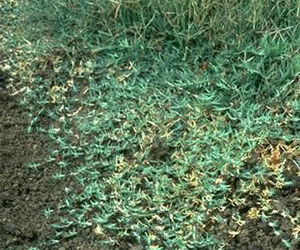 Bermudagrass is a perennial grass, growing rapidly when temperatures are warm and moisture is plentiful, such as in an almond orchard.
Bermudagrass is a perennial grass, growing rapidly when temperatures are warm and moisture is plentiful, such as in an almond orchard.
Picture courtesy of the UC IPM Project © 2000 Regents, University of California.
Photo by Jack Kelly Clark.
Weeds are a seemingly constant issue in the orchard. If not managed properly, they can create competition among young trees, clog micro-irrigation systems, use and generate uneven irrigation and contribute to a messy orchard floor during harvest. Good weed management, then, starts with identifying the weeds in your orchard, which requires constant, attentive monitoring.
The University of California’s (UC) Integrated Pest Management (IPM) guidelines recommend the following actions for monitoring weeds:
- Survey your orchard for weeds in late fall and again in late spring.
- Monitor the orchard in a thorough fashion. Include the entire orchard as well as field margins, ditch banks and irrigation canals in your survey.
- Examine all areas that are susceptible to weed infestation, like areas of high moisture. Collect important information such as weed species, location in the field, degree of control achieved with current program, and herbicides applied.
- Record observations on a survey form that includes a map so the infested sites can be revisited for weed control. Pay particular attention to perennial weeds and other problem weeds and note their location on the map.
- Record weeds found in rows and middles separately. Weeds in tree rows must be managed, but annual weeds in row middles — i.e. cover crops — may have some benefit as an orchard floor cover.
Once you know what you’re dealing with, look to select herbicides or other control techniques based on what kinds of weeds are actually present in the orchard. The UC IPM website provides a comprehensive list of common and scientific names of weeds, along with photos and descriptions of each. You can find that list here.
In the late spring, the most important invasive weeds to look out for are perennial weeds. These weeds can be a pervasive problem for almond growers, so weed management practices should be geared toward preventing their growth in the rows or row middles of the orchard. Common perennial weeds you’ll see are Bermudagrass, Johnsongrass, Dallisgrass, Nutsedges and White Clovers. Also, tufted perennial grasses such as threespike goosegrass are especially problematic during the beginning years of tree nut establishment due to their ability to reduce three growth by competing for water, nutrients and sunlight. Once the almond trees reach their fourth leaf, established plants can reduce harvest efficiency by making it more difficult to recover nuts from the orchard floor at harvest. The UC IPM website provides a late-spring weed survey form to help you identify these pests as June approaches.
Once weeds are properly identified and the correct herbicides are applied, it’s vital to control herbicide resistance by using a variety of weed-control strategies. Failure to do so can result in the rapid loss of an herbicide’s effectiveness — and there are very few new herbicide technologies in the pipeline.
Detecting resistance is the second step in preventing resistance. Patterns of herbicide resistance include patches of dense weeds with less dense populations radiating out from the central patch and weeds that have escaped control, scattered throughout the field.
To combat resistance and reduce weed seed spreading, the UC IPM recommends the follow steps:
- Rotate herbicides that have different modes of action and Weed Science Society of America (WSSA) group numbers.
- Drew Wolter, UCCE Junior Specialist Horticulture Intern under Brad Hanson recently published an article on herbicide performance that helps demonstrate the importance of rotating applications.
- Monitor for weed survival after an herbicide application.
- Include non-chemical weed control methods such as cultivation or hand weeding.
- Clean equipment after working in weed-contaminated orchards to prevent the spread of weed seeds.
- Control weeds suspected of herbicide resistance before they can produce seed.
- If weeds escape treatment, use shovels, hoes, and other hand tools to cut the plants below the soil surface to prevent flowering.
- Use a pre-emergent herbicide before weeds appear. When the weeds emerge in fall and spring, consider splitting applications to meet the multiple emergence windows.
Weed management is vital to a successful growing season and — with the right steps — can improve the yield and growth of established trees.
For more resources regarding weed management, please visit the follow links on the UC IPM website: